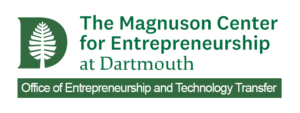Building Backward to Biotech
Author, consultant and biotech cofounder Stephanie Wisner spoke with the Third Cohort of the The Dartmouth Innovations Accelerator for Cancer (DIAC) about the importance of approaching innovation with the end goal in mind.

When Stephanie Wisner was studying chemistry and chemical biology at Cornell University, she was always mindful of how her research might ultimately impact people. When she later became a medical scribe, she encountered a disconnect between the novel scientific research she saw at the bench, and the options available to patients in the clinic.
“I saw patients that didn’t have any more medical options. On the flip side, I was working in the lab and saw all these novel technologies without a path to real-world application,” Wisner says. “That really bothered me.”
Wisner pivoted her career, getting her MBA from the University of Chicago. She moved into the venture capital space, working at ARCH Venture Partners. Afterwards, she started a consulting business, BioVenture Advising, to work with early-stage scientific startups on commercialization strategy, capital raising, and business development. In 2021, she cofounded Centivax, Inc. (along with Jacob Glanville, the CEO and primary scientific founder), where she is now chief business officer.
This year, she published “Building Backwards to Biotech: The Power of Entrepreneurship to Drive Cutting-Edge Science to Market.” The book is about biotech entrepreneurship, and how the concept of “Building Backwards” is an effective strategy to increase a start-up’s probability of success.
“I became passionate about helping other scientists interested in pivoting from academic research to starting or joining biotech companies. Many were having difficulty because they didn’t understand the industry; how it works is a bit non-transparent,” Wisner says.
Last week, Wisner — who was on Forbes’ 30 Under 30 list this year — spoke with the Third Cohort of the Dartmouth Innovations Accelerator for Cancer (DIAC) about the importance of defining a clear end goal when developing new biotech innovation. Here are her tips.
Recognize the difference between good science, and good business.
Scientists trained in an academic setting are used to searching for novel discoveries, but the end goal of research, which is often publishing papers and securing grant funding, are very different end goals than are needed in a business.
In addition, “not all good science makes a good business,” Wisner says. It helps to develop intuition about which scientific innovations would make strong businesses.
Run value-building experiments.
The scientific process in a biotech company should be guided not solely by curiosity alone, but with an eye toward de-risking the company and moving it toward specific milestones — like reaching clinical trials — that drastically increases valuation.
"The value of a biotech company does not increase in a gradual slope, it’s a stepwise function as you progress to specific milestones,” Wisner says.
Founders should be focused on reaching the next value inflection point, with the minimal amount of investment.
“To oversimplify a bit, for each dollar you spend, you should get more than a dollar’s return in data that decreases the risk and improves the rate of success,” Wisner says.
For academic scientists, this change in mindset can be challenging. So, founders need to utilize “building backwards” thinking at the beginning of the company’s life — or at least surround themselves with people who will help with that, Wisner says.
“That doesn’t have to be your expertise. Great scientific founders keep those people around them,” she says.
Begin with the problem you aim to solve.
Too often, biotech founders are overly focused on the technology they initially want to begin a company around. Sometimes, this technology was something they worked on during their doctorate. Starting with a particular technology can work, Wisner says.
Yet, “the best way to build a successful biotech company is not to be overly wedded to a particular technology, but rather, have a clear understanding of the particular medical problem to solve in the market, and then find the best technology to solve that problem.”
A business, in order to be successful, must create a product that meets a real world need in a novel enough way that the problem/solution match can generate “the appropriate excitement and energy to attract a top-notch team and investors,” Wisner says.
"More often than scientists expect, there’s not a strong link between what they’re doing in the lab and the real world marketplace,” Wisner says. "Getting revenue is a measure of the fact that you’re meeting a genuine need. But meeting a genuine need only happens if you plan your business around that from the beginning and then consistently throughout development.”
Defining the end goal — say, to provide a novel mechanism of action disease-modifying treatment for patients with congestive heart failure and advance into clinical trials as efficiently as possible— will ultimately focus both the business development process, as a “market niche” is carved out, while focusing the scientific development process as the data needed can be more clearly defined.
A business “isn’t a perfect measure of the best product to help,” Wisner says, “but it’s a very effective tool for bringing something to market that people want and need.”
Innovating better vaccines
Wisner isn’t just a consultant and expert on biotech innovation. She’s also co-founder and chief business officer at Centivax, a biotech startup focused on developing broad-spectrum vaccines — as an example of one application, a COVID vaccine that will protect against all current and future variants.
“I was inspired to write the book in part because of things I’ve observed at Centivax,” she says.
The company was started before the pandemic, but the mission has become even more critical over the past two and a half years. As co-founder, Wisner has used her focused approach to biotech innovation to help move products towards market at a focused and efficient pace.
“This problem has always been there, there’s just more awareness now,” she says. “My role is helping the solution become a reality.”
For more information on Stephanie Wisner, connect on LinkedIn. “Building Backwards to Biotech” is available here.

